The correct way to throw a boomerang is like you would throw a baseball: overhand.
If you throw your boomerang side-arm or like a frisbee, it will climb straight up in the air, then
come almost straight down and possibly hit someone or the ground and break in half!
There are two basic ways to grip your boomerang, the pincer or pinch grip and
the wraparound grip. The pinch grip consists of simply pinching the boomerang
between your thumb and forefinger, allowing friction to keep the boomerang in
your hand during the throw. Snap your wrist at the end of the throw to create
spin, and momentum will help pull the boomerang from your hand. The wraparound
grip is similar to the pinch grip, the difference being that you wrap your
forefinger around the front of the boomerang.
I am a staunch proponent of the pinch grip of the trailing or dingle wing. I can get much more spin from the pinch grip. I use a fingertip moistener called SORTKWIK© to give my finger and thumb a slight frictional advantage rather than licking my fingers. This is much better hygienically. The SORTKWIK© is available in most office supply stores in the mailing section.
Creating maximum spin is necessary for a
good throw. So use the grip which is most comfortable and allows you to create
maximum spin.

The boomerang has two wings: the lift or leading wing and the trailing wing. The trailing wing is also called the dingle wing or arm but that is becoming the less preferred name
In the picture you may think that the leading wing should be the one that appears to be in the front, however the leading wing is named because of the geometry of the boomerang. As it is rotating counterclockwise, the leading wing cuts through the air with the trailing wing following closely behind in the wake of the leading wing. The boomerang can be thrown from either of these wings.
The most curved side (usually the painted side ) of the boomerang must be facing you with the flat side facing away. Otherwise the boomerang will rotate backwards and the airfoils will not
generate lift.
The amount of tilt or layover (the amount of tilt the boomerang has from straight up and down or vertical) is important to the path of the flight. In calm to light wind conditions use more layover (tilt the boomerang 20 to 30 degrees away from vertical). This will cause a higher, elliptical flight. In higher winds, hold the boomerang up towards the vertical, for a lower, rounder flight.
Throw your boomerang straight out or at a slight upward angle. Don't
throw it high into the air, let the lift built into the airfoils keep it aloft.
Thrown correctly, your boomerang will fly straight out for a distance,
then begin a constant turn to the left. It is this turn to the left that makes the
boomerang fly in a circle and return to you. This is caused by a combination of gyroscopic precession due to uneven lift of the airfoils at the top of the rotation relative to the bottom of the rotation of the boomerang in flight and the vertical component of lift due to the airfoils.
Fine-tuning your throw
Boomerangs do come back
The direction of the throw, relative to the wind is CRITICAL. The
boomerang must be thrown 30 to 90 degrees to the right of the wind heading for right handed throwers and 30-90 degrees to the left of the wind heading for left handed throwers. Don't forget a right handed boomerang is a mirror image of a left handed boomerang. Be sure you get the proper one for you. To determine the proper direction of the
throw, use a piece of light surveyors tape or pick up some leaves or grass clippings and drop them. Observe which
way the wind blows the tape or the clippings. Face directly into the wind, so it's blowing
right into your face. Turn about 60 degrees or so to your right. The wind should
now be blowing from your left to your right. Throw your boomerang in the
direction you are facing.For lefties reverse everything. You will be throwing to the left with the wind blowing from your right.

If the boomerang: Returns and lands in front of you, turn slightly to
your left and throw more into the wind.
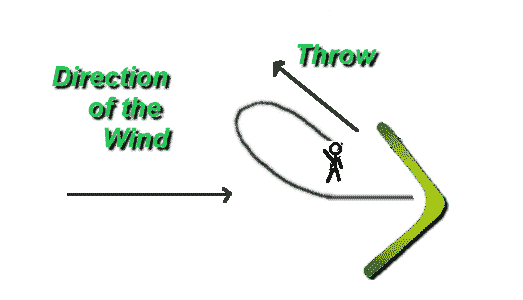
If the boomerang: Returns and lands behind you, turn to your right and face
more away from the wind.
If the boomerang returns to where you are standing but is too high
to catch, throw easier or hold the boomerang up closer
to vertical.
If the boomerang is headed back in your
direction but hits the ground before it reaches you,
throw harder or use more layover.
If the boomerang flies straight out and hits
the ground, you need more spin or you've thrown it
with the airfoils on the wrong side.

This is what a good throw should look like!
Every boomerang is different unless it is made with a machine(anyone have a boomerang making machine?) Experimenting with different throws and in differing wind conditions will improve your skill in
having the boomerang fly exactly how you want it to. Always throw from the same spot, so if
you have to move to catch or retrieve your boomerang, you can see how close it returned to the spot you threw from. I mark my spot with a flag made from surveyors tape. Always return to this spot to throw again.
Very few boomerangs will return completely in dead calm.
The sport of boomeranging is a developed skill, like throwing a disc or
hitting a golf ball. It takes practice. To take a carved piece of wood
and throw it 150 feet away, only to have it turn and fly back to you to be caught,
is like making a 3 point shot in basketball. You have to go and get your
disc or ball. Your boomerang, on the other hand, comes back to you to be thrown again.
Tuning Your Boomerang
After you have learned to throw properly, you will learn the characteristics of your boomerang. If you boomerang refuses to fly properly, even though you have learned to judge the wind and have mastered the layover concept, there are several things you can do to improve its flight. Most boomerangs require positive dihedral. Lay your boomerang on a flat surface with the paint side up. Push one wing tip down to the surface top..The other wing should be lifted a few millimeters off of the surface as if the boomerang has a slight v shape. This is positive dihedral. This helps give the boomerang lift. If your boomerang goes too high you need to decrease the positive dihedral. If it continually crashes, you need to increase the positive dihedral.

In the field, you can increase or decrease the dihedral by bending the boomerang slightly wings up for positive or wings down for negative dihedral and it will affect your throw accordingly. This is only temporary for a throw or two.
Advanced Tuning Tips
There are more subtle changes you can make when you become a more accomplished thrower. These are changes that should be made only if you are very familiar with the characteristics of your boomerang. These are shown below. If you are lefthanded, and are throwing a lefthanded boomerang, just reverse these instructions as a mirror image.
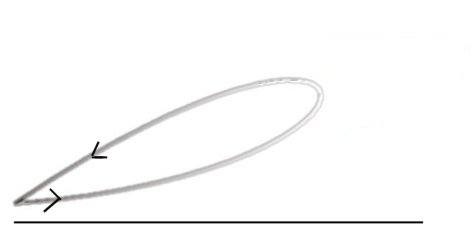
Consider this flight path to be a perfect throw.
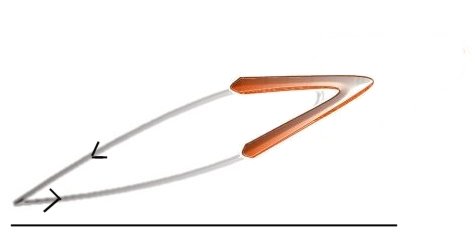
Align your boomerang on the flight path
Holding your boomerang in front of you at arms length, align it horizontally so that the
alignment simulates the flight path with the right or leading wing on the right hand side of the
path and the left or trailing wing on the left, such that you can imagine that the boomerang is superimposed on the flight path. I have taken an observers view to the right and slightly above the picture so that I can show you the tuning from the side.
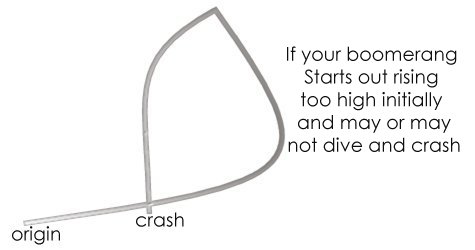
Then bend the right wing of your boomerang down like so:
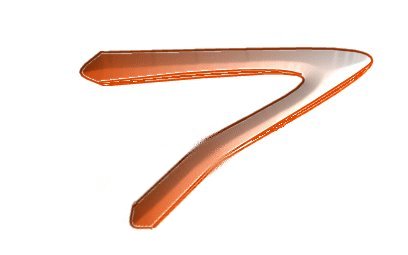

Then gently bend the right wing of your boomerang up like this:

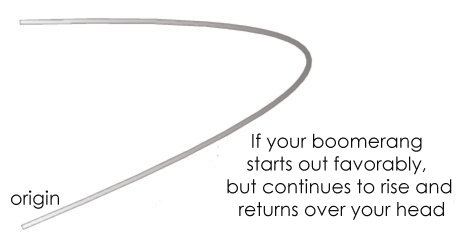
Then bend the left wing of the boomerang down:

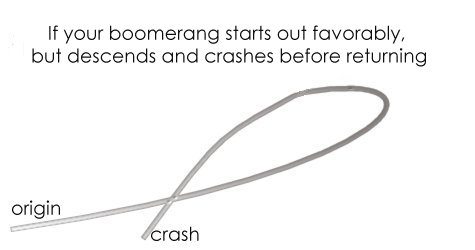
Then bend the left wing of your boomerang up:
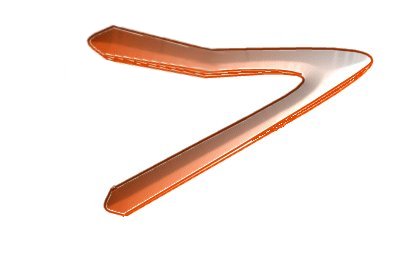
Please notice the correllation of the right and left parts of the flight path and the right and left wings of the boomerang. Right part of flight path too high, bend the right wing down, etc.
These field tuning tips are temporary at best. The bending in these graphics is exaggerated to show principle. You will not see that much bend in the wing.
The wood will retain the temporary bend for a flight or two to let you know where to make more permanent adjustments. To make it more permanent, heat your boomerang in a microwave oven for 13 to 15 seconds (this is as long as the finish will stand) and either hold it in the position you want until it cools or clamp it in that position. The plywood glue will soften and reset in the new position as it cools ( small changes).
I would like to thank Dr. Fred Malmberg (fmalmb@pol.net) for the initial article in Many Happy Returns that lead me to produce this page. He originated the superimposition technique of individual wing tuning. Thanks Dr Fred!
When you have succeeded in tuning your boomerang and are getting repeatable returns, you may want to apply an acronymic system for remembering how to throw it. Pat Steigman has the Acronym WELSH fully explained on his page so I won't try to explain it here.
You may want to learn this system and write the numbers on the back of your boom.
Catching your boomerang
The best way to catch a returning boomerang is to trap it between the
palms of your hands in a "sandwich" catch. Wait until your boomerang is below shoulder level, then
place one hand above and one below your boomerang, "clap" your hands
together, trapping the boomerang between. If you want to try one handed
catches, stick your hand into the open hole in the center of the spinning
boomerang and grab. Try this technique only if your boomerang is well above
your head or below your shoulders, because the boomerang can spin off your
hand changing directions abruptly, and could hit you about the head or face. It is important in this sport as well as in other sports to use eye protection as boomerangs are potentially hazardous if used carelessly.
The flight path of a boomerang changes constantly during a flight. If you look away from a boomerang in flight, it is difficult to find it again.
If you do look away (you trip over your marker) glance quickly in
the area you expect the boomerang to be. If you don't see it right away, don't
stand there and stare! A boomerang returning at close to eye level is almost
impossible to spot and will hurt if it hits you in the face. If you don't spot it
immediately, assume the "ducked head position", turn your back, cover
your head with your arms, and duck down. This will limit the area that you can be hit to your back.